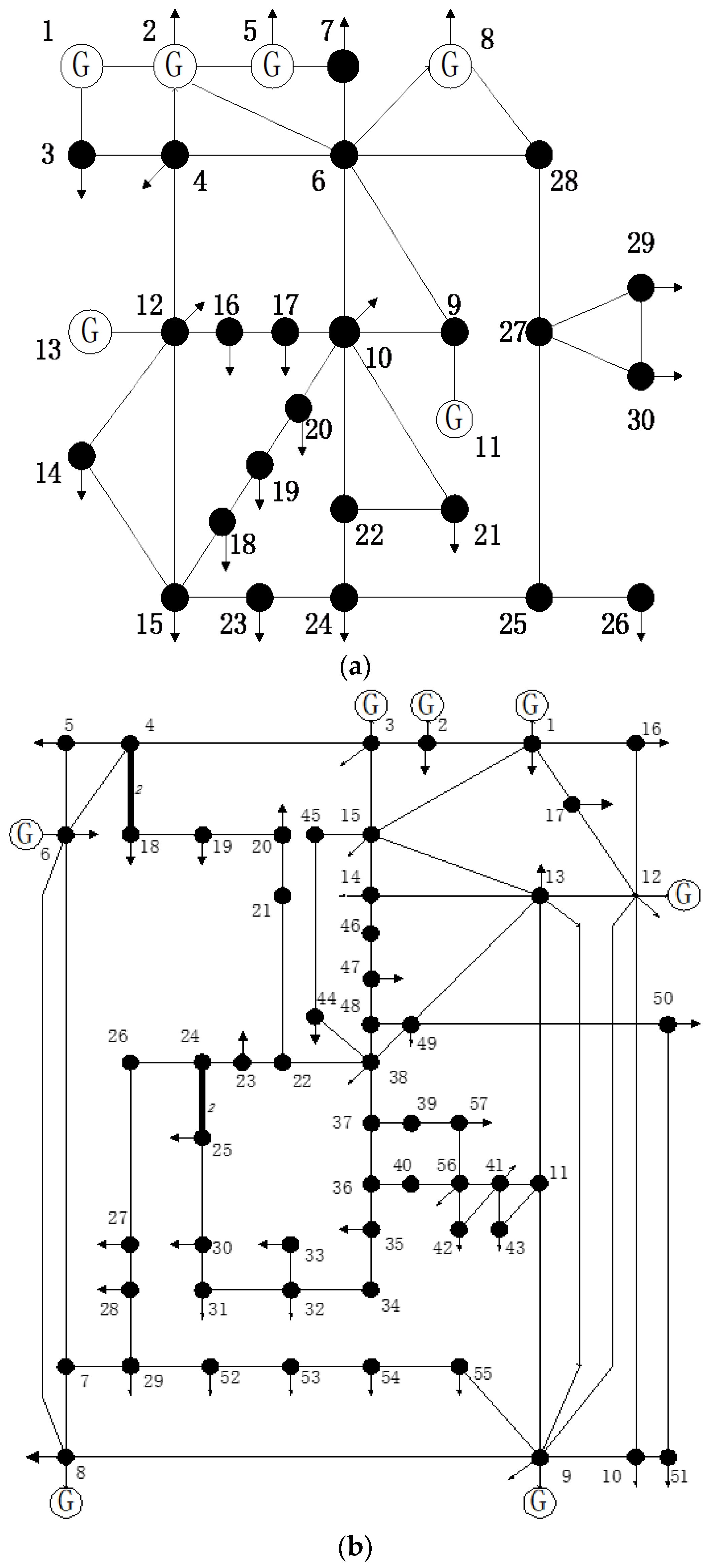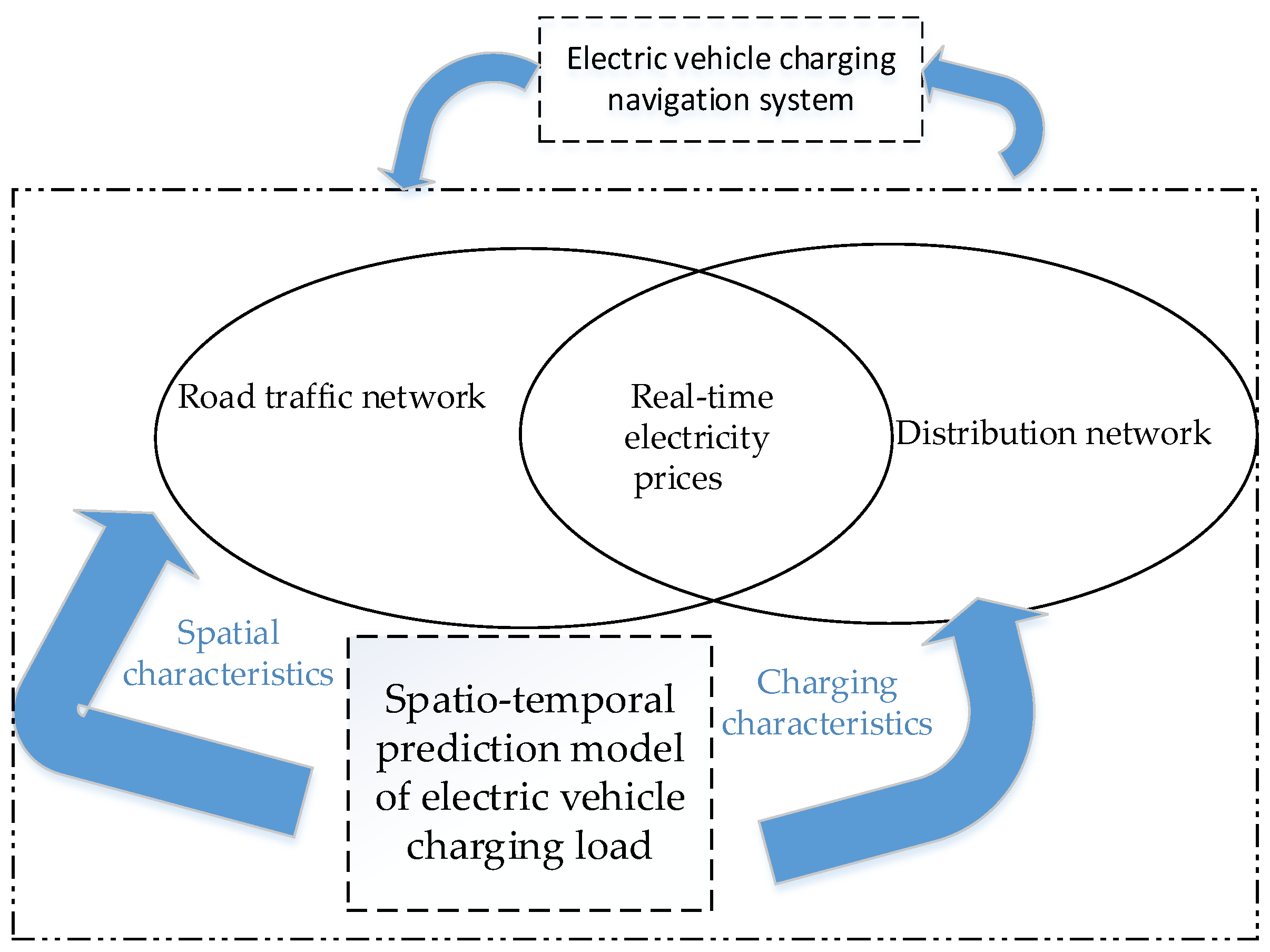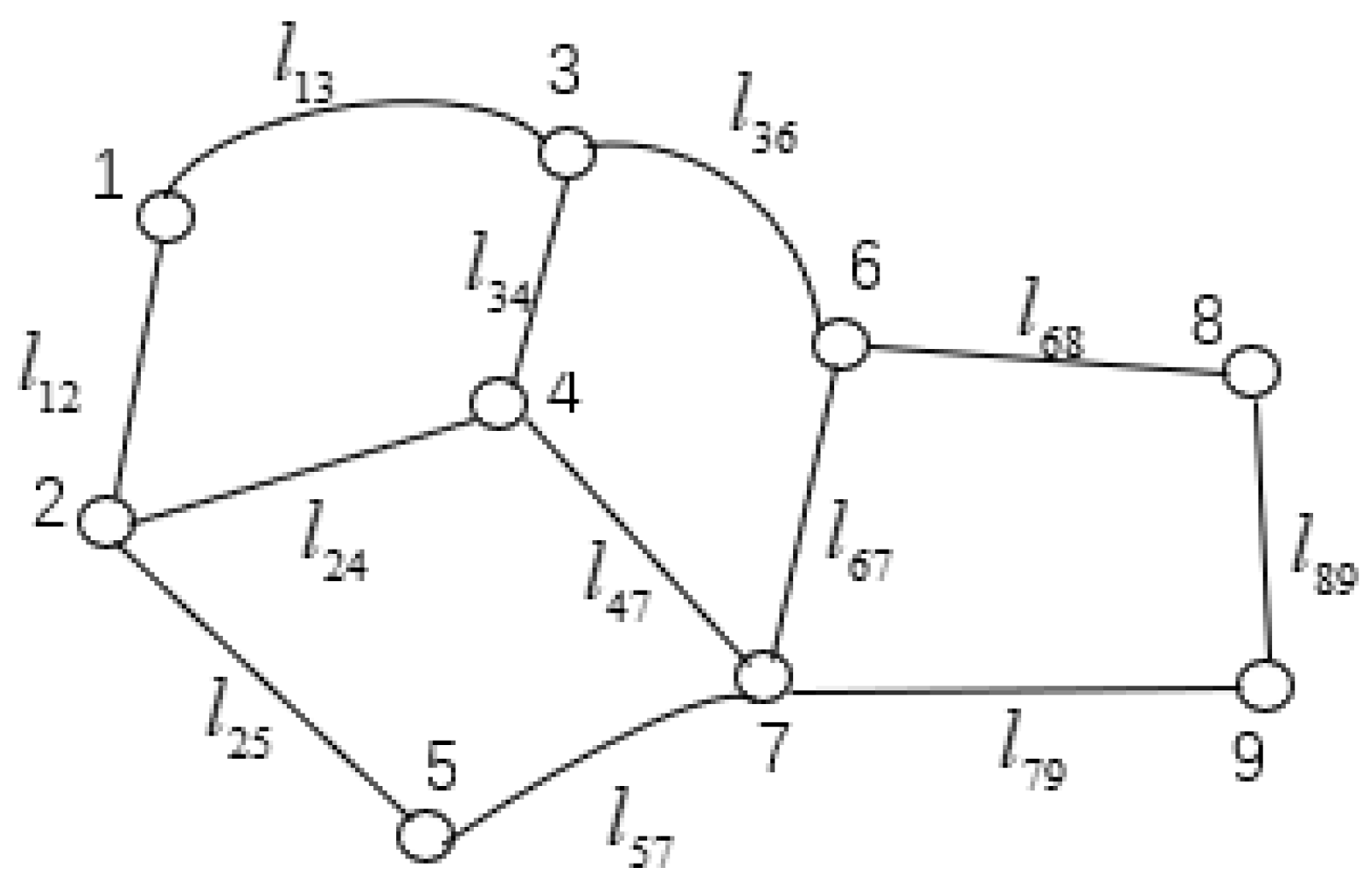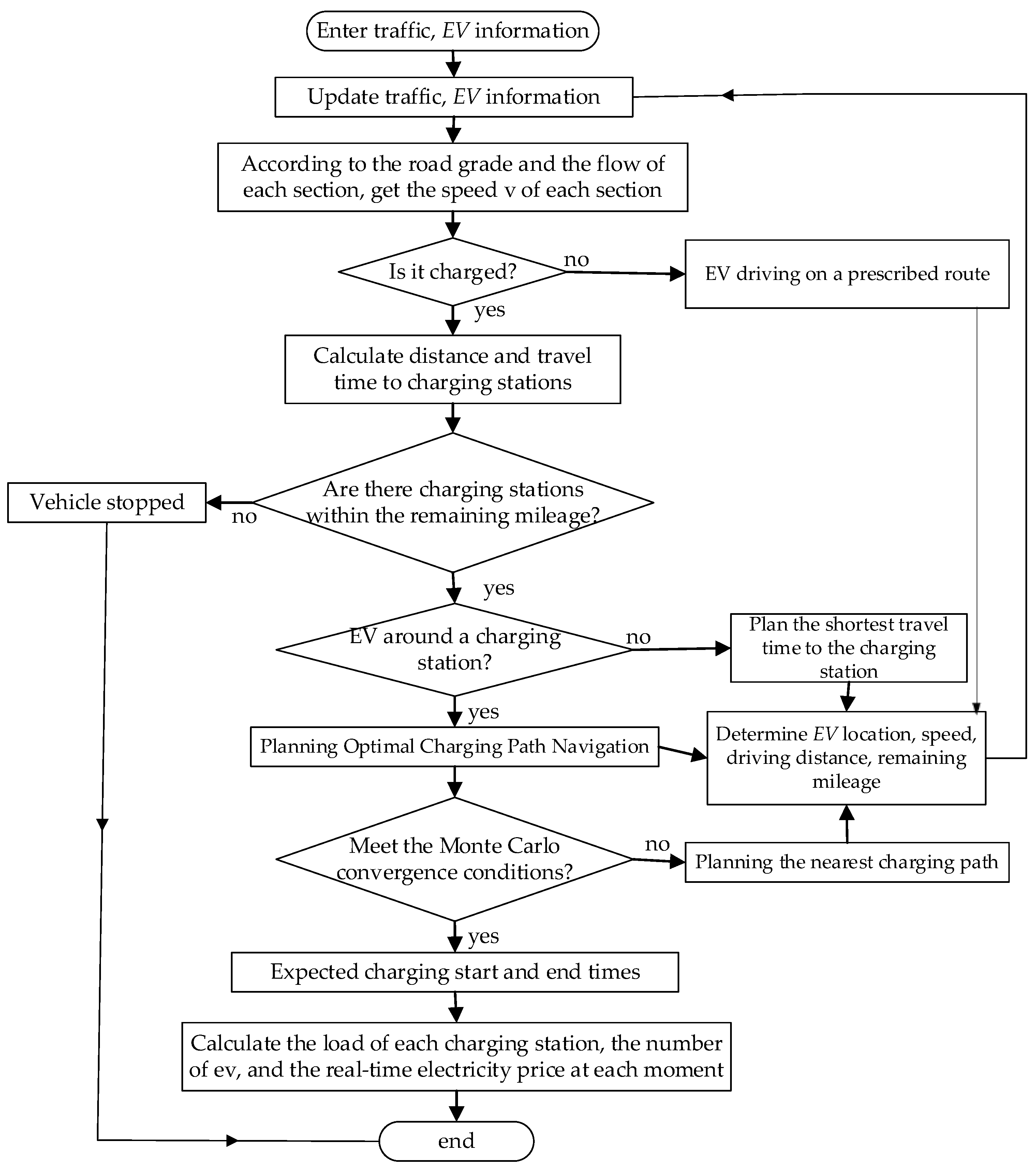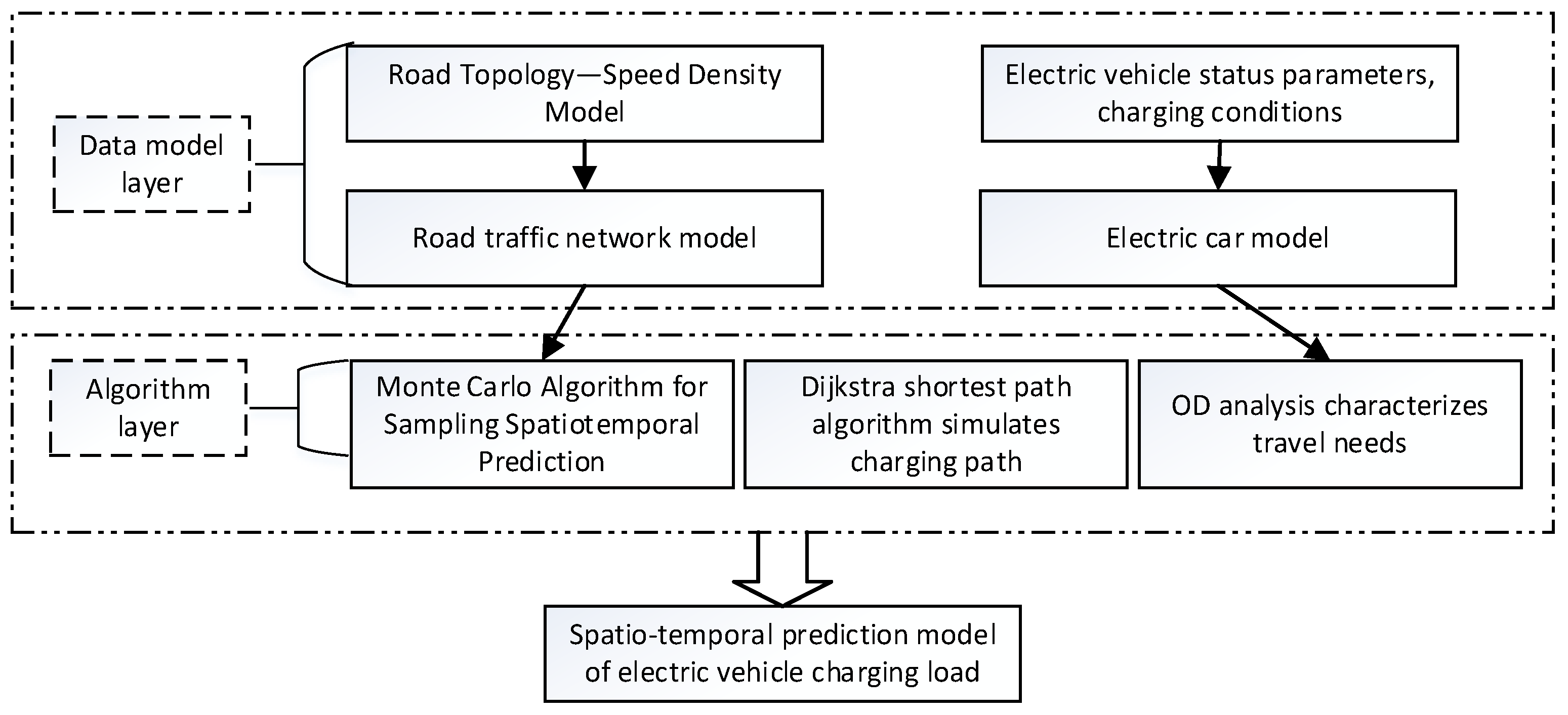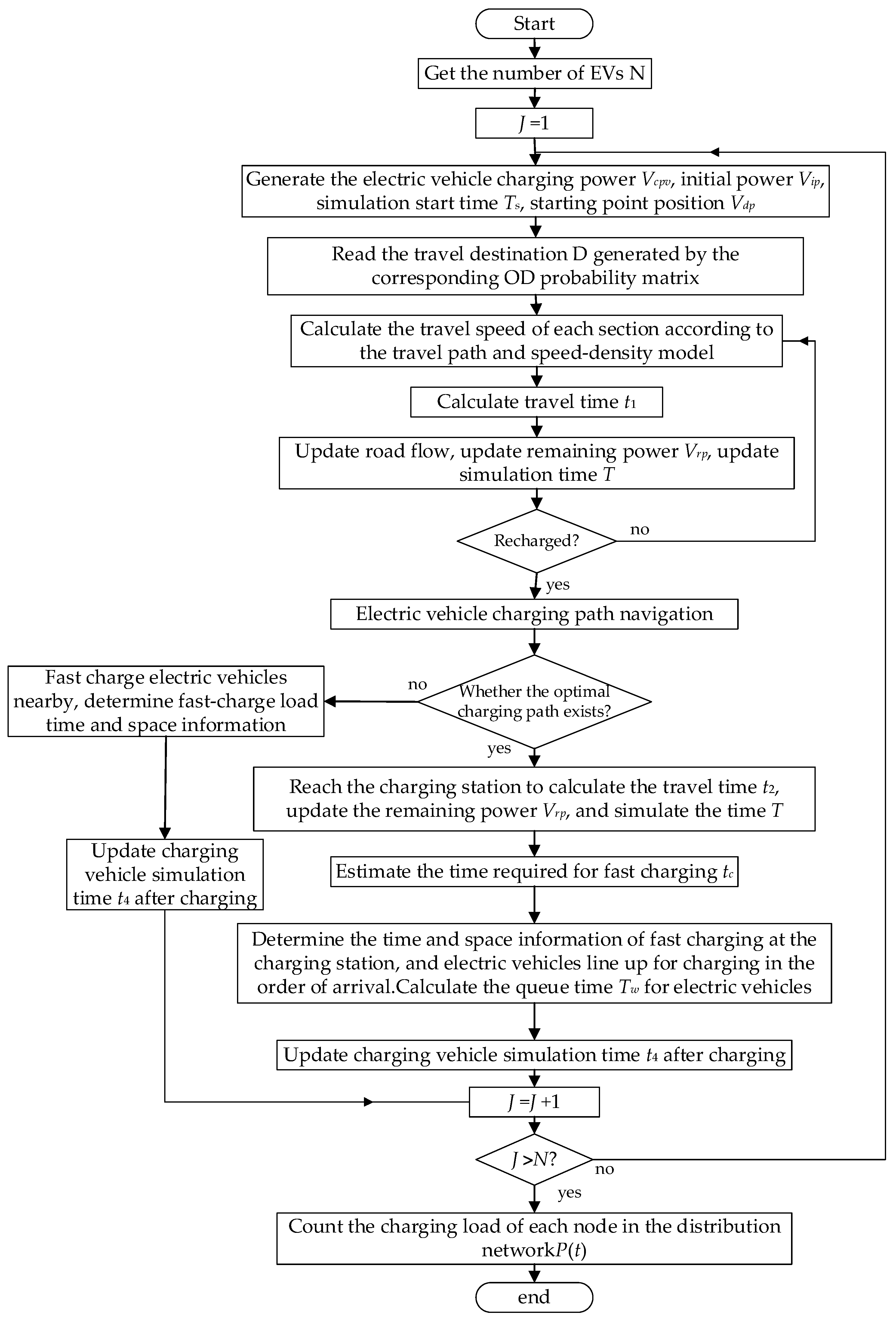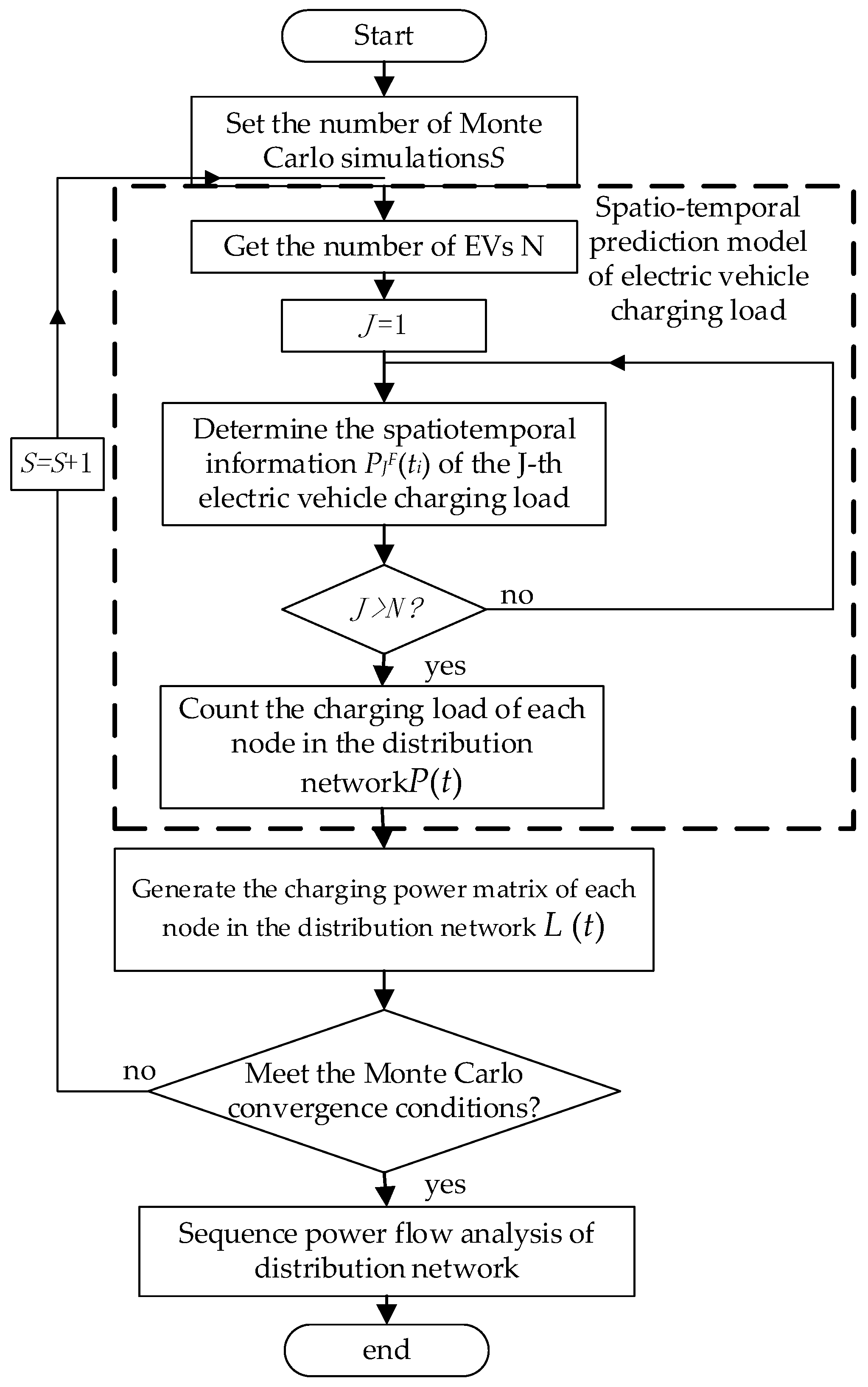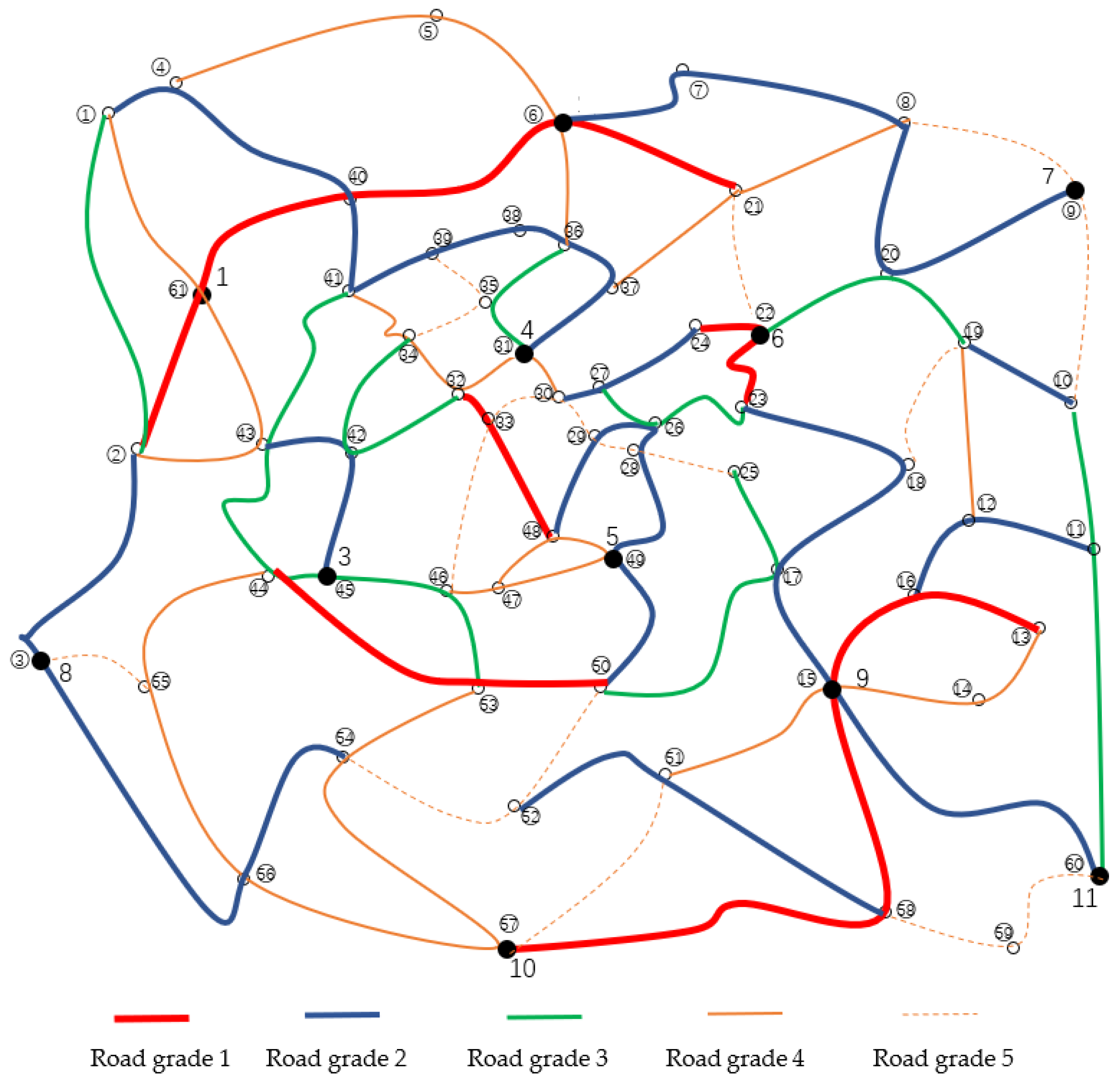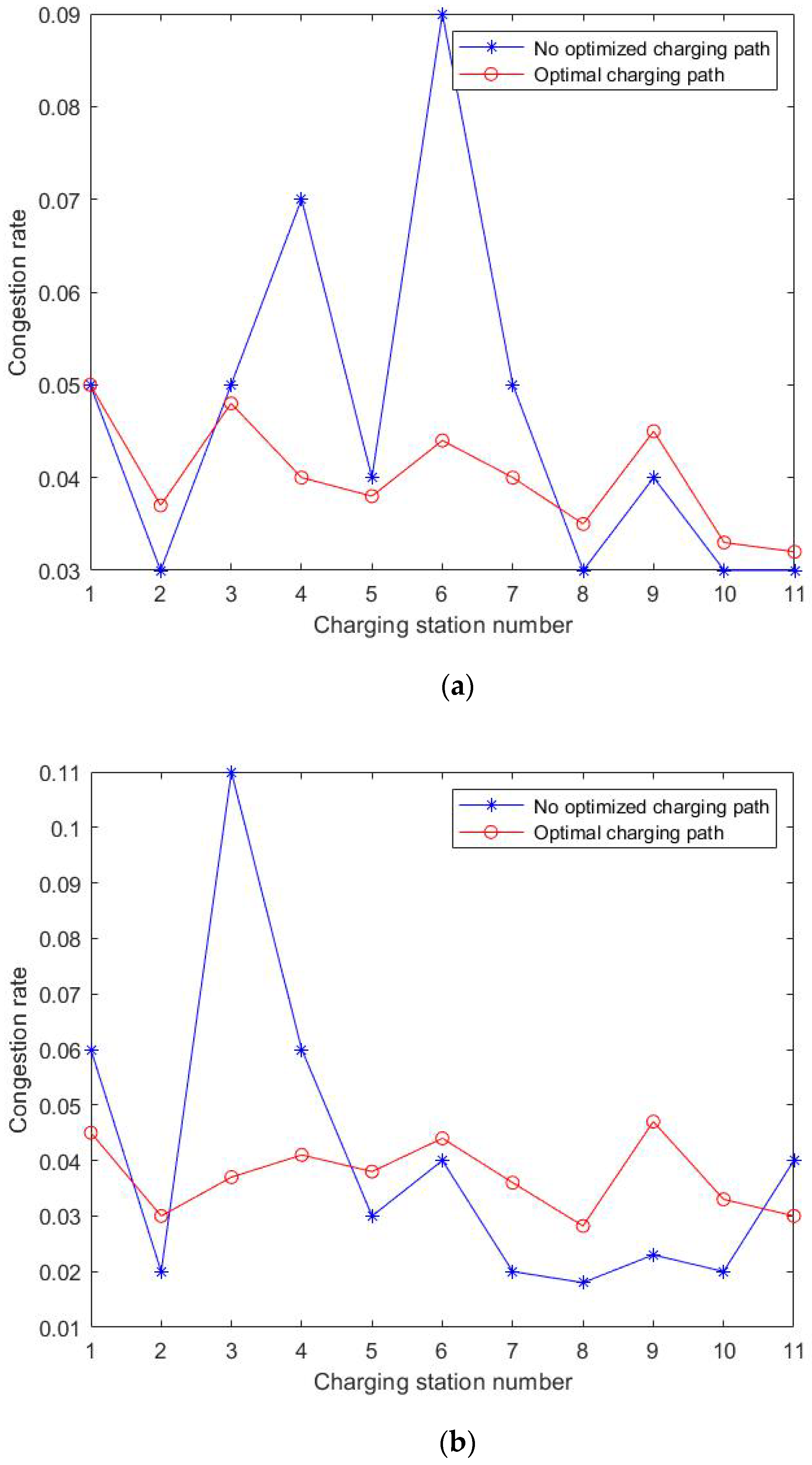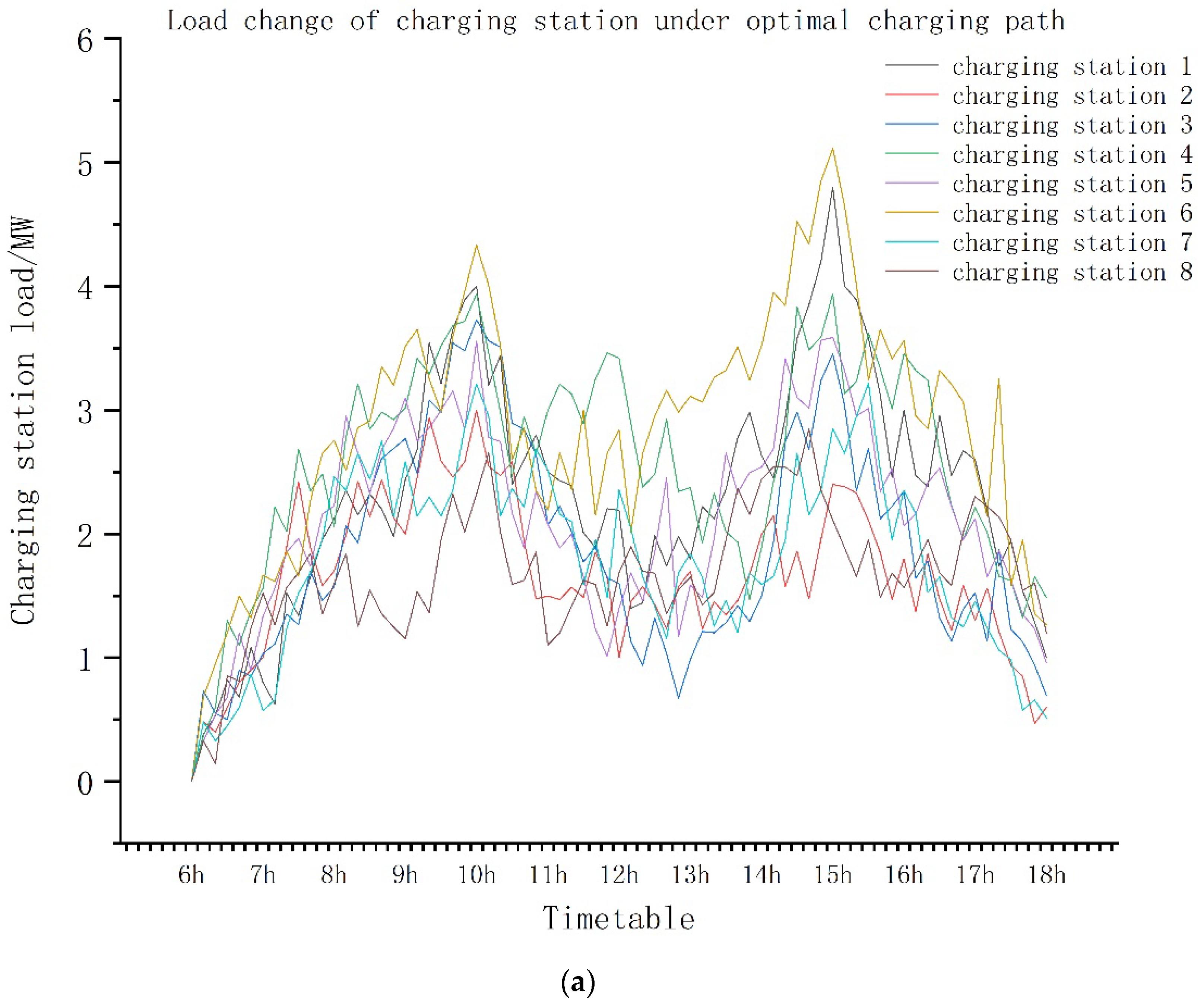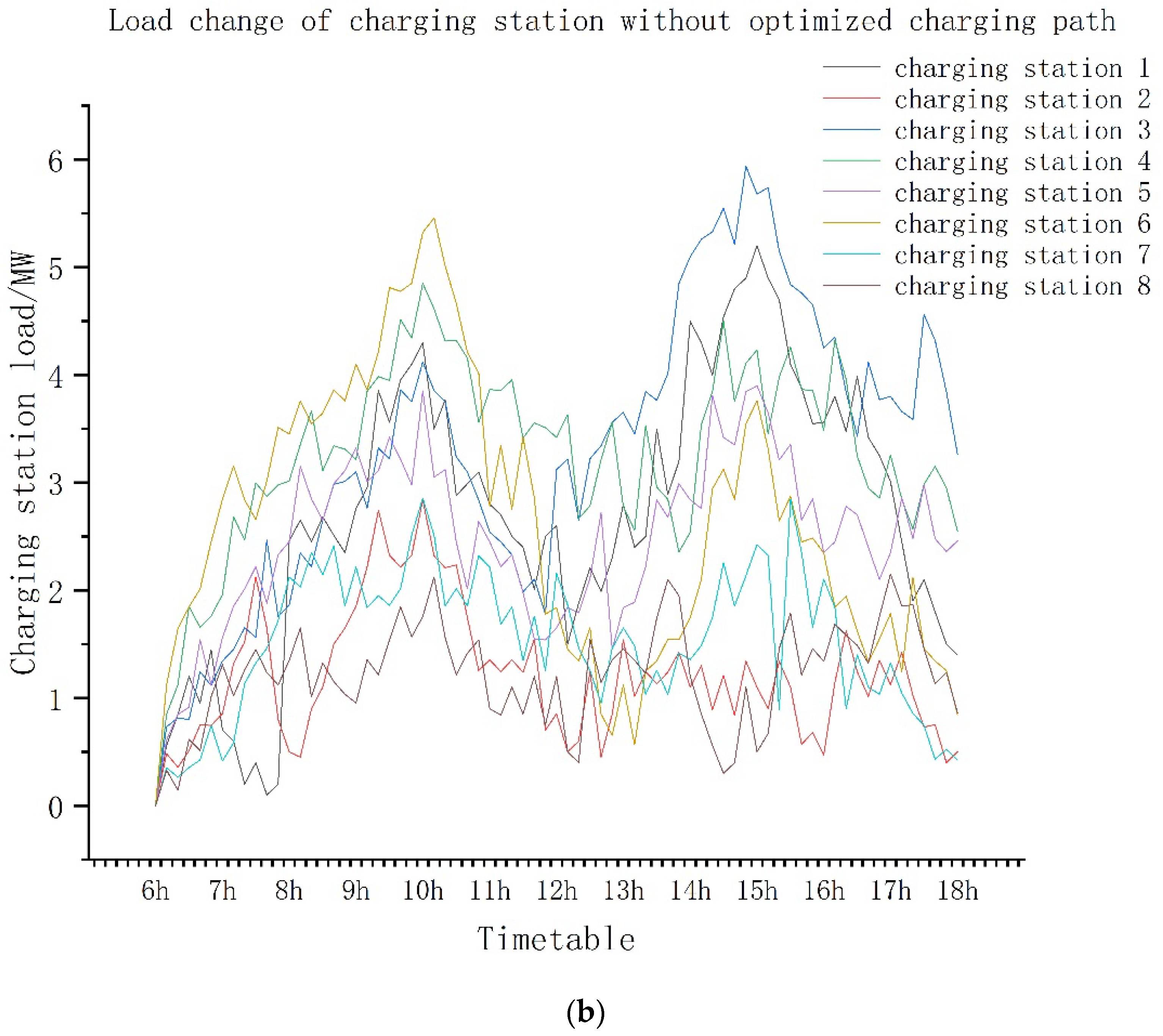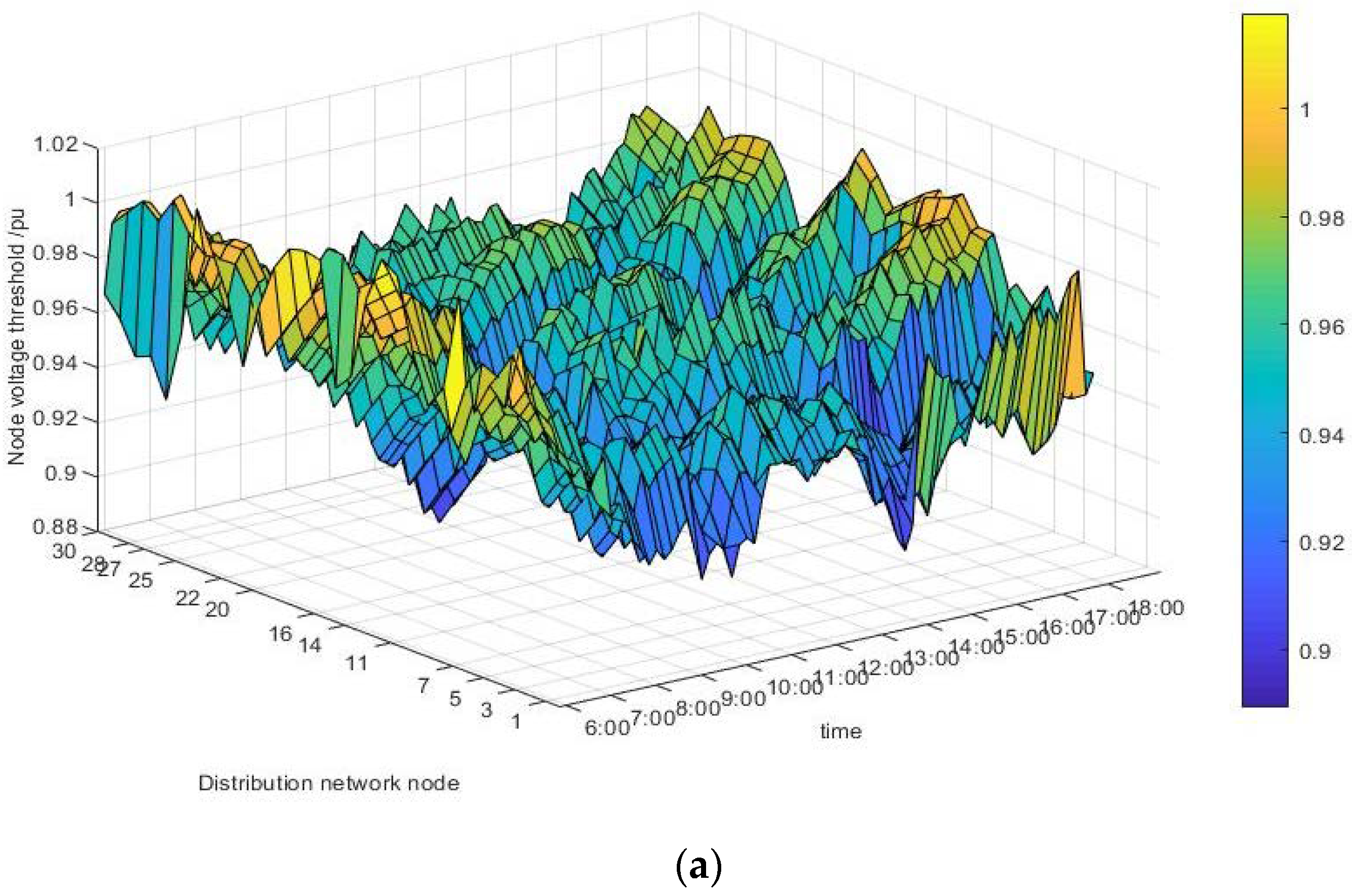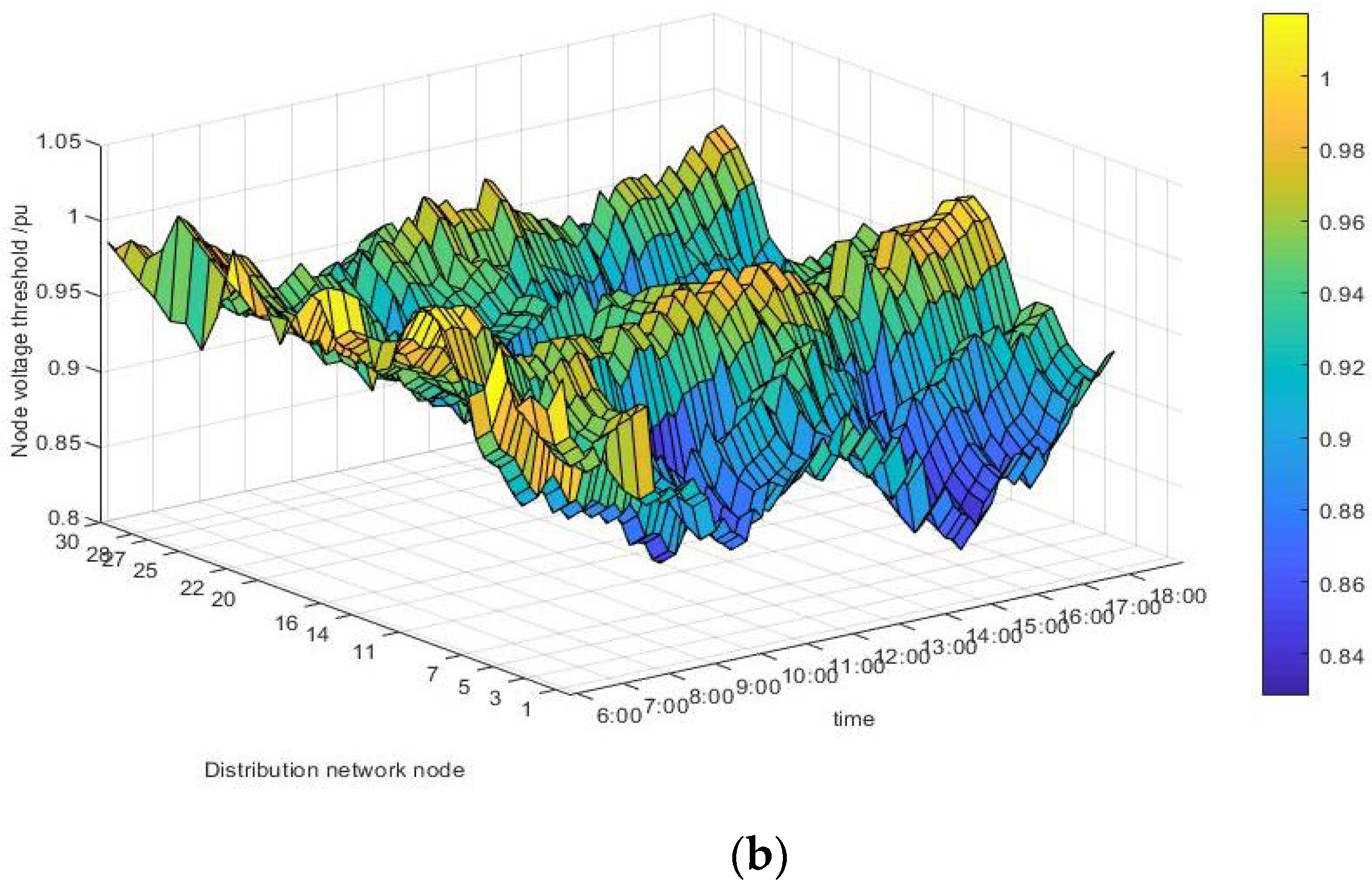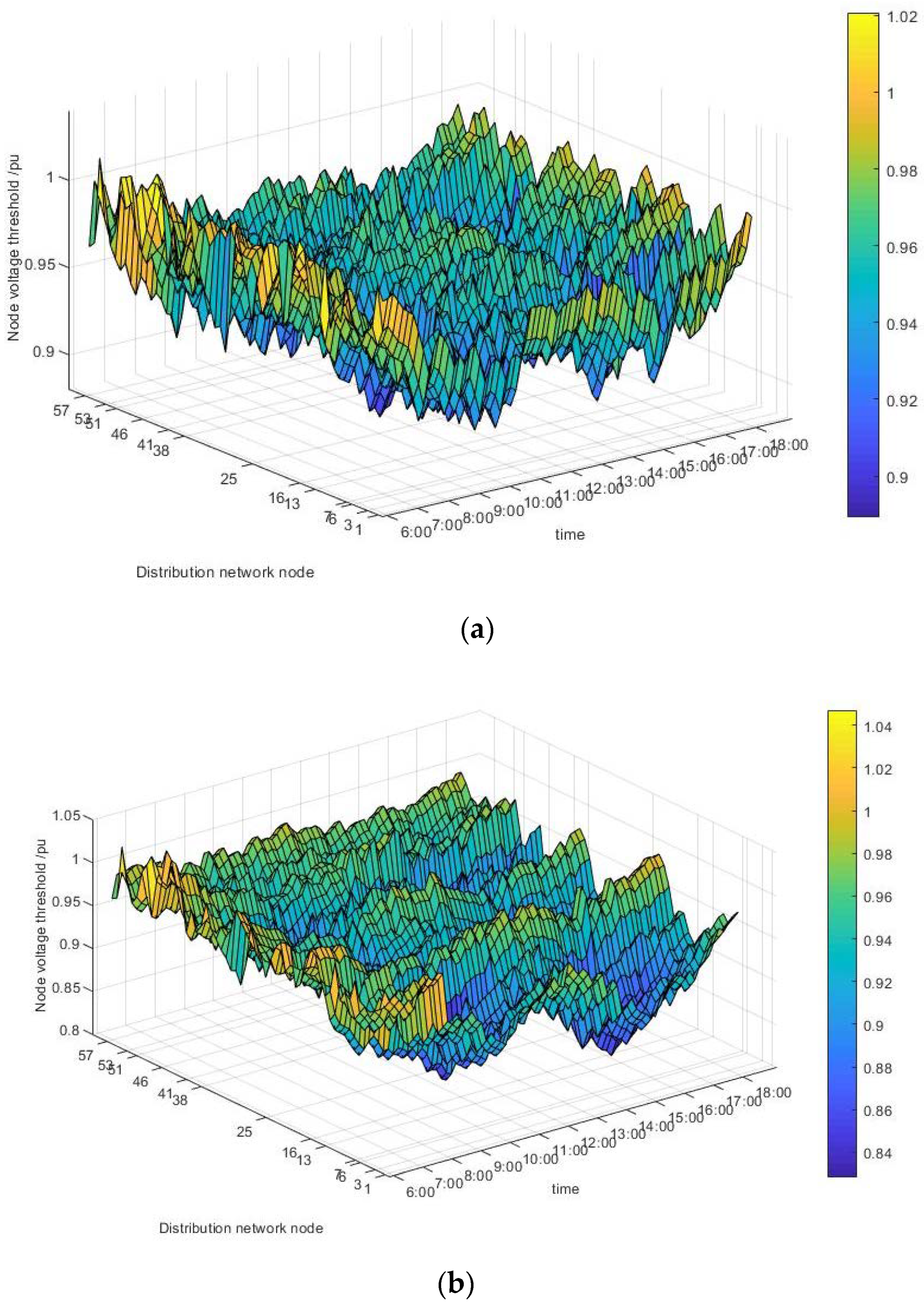1. Introduction
The World Oil Outlook 2017 claimed that the transport sector accounted for 54.6% of world oil consumption in 2017 [
1]. According to this report, this sector will consume 64.9% of the world’s oil consumption by 2040. With the development of industrialization, the global awareness of the energy crisis is increasing. Compared with the current depletion of traditional petroleum resources, electric vehicles (EVs), which are treated as a low-carbon green vehicle driven by electricity, undoubtedly could offer energy conservation and emission reduction in the future, and these should be research goals.
As a timesaving and efficient charging method, fast charging is becoming more and more popular among users as electric vehicles become popular. Affected by electric vehicle travel characteristics and road structure, the fast charging demand for electric vehicles has some obvious spatiotemporal distribution characteristics. At present, the layout of China’s fast-charging stations does not match the distribution of charging demand. Therefore, problems such as uneven utilization of fast-charging stations, long vehicle queuing time, and large voltage shifts in the distribution network need to be resolved [
2].
According to the Global EV Outlook [
3], the number of EVs worldwide could exceed 130 million by 2030 under the assumption that government policies continue supporting the expansion of electromobility. Due to the unique charging characteristics of electric vehicles, the charging behavior of large-scale electric vehicles not only puts pressure on the transportation system but also affects the safe and stable operation of the distribution network [
4,
5,
6].
Spitzer, M. researched on optimized integration of electric vehicles in low-voltage distribution grids and analyzed the impact of uncoordinated charging, as well as optimization-based coordination strategies on the voltage stability and phase unbalances of a representative European semi-urban low voltage grid, and solved the phase imbalance problem of distribution networks [
7]. Two papers [
8,
9] also proposed a good strategy to reduce phase imbalance; Jabalameli proposed charge/discharge strategies for plug-in electric vehicles in unbalanced active power distribution networks with reactive power compensation to compensate for phase imbalance in the distribution network through reactive power compensation; and found single-phase residential charging can also initiate or contribute to voltage unbalance conditions in the distribution networks [
8]. Muratori focuses on the impact of plug-in electric vehicle (PEV) charging behavior on residential power demand and uses highly analyzed residential electricity demand models and PEV usage to assess the impact of uncoordinated household PEV charging on residential electricity consumption [
9]; Diaz-Londono proposed a charging strategy to improve the flexibility of electric vehicle charging stations [
10]. By providing specific definitions of the flexibility of charging stations, two optimal charging strategies were given to achieve the purpose of reducing the operating costs of charging stations. Among them, two studies [
7,
8] also discussed the impact of price on grid stability. [
7] considered the actual arrival and departure time of electric vehicles and provided a coordinated charging strategy to optimize the distribution network. [
8] improved the node voltage curve by providing reactive power injection of PEV inverters on selected nodes based on variable pricing/contract schemes.
At present, research on the charging path planning of large-scale electric vehicles based on traffic conditions and distribution network conditions is still very rare. Kobayashi Yuichi identified an electric vehicle charging path planning method based on the starting and ending traffic locations of an electric vehicle and actual traffic congestion [
11]. Guo proposed “electrical distance” based on traffic simulation; established a path optimization framework that integrates transportation systems and charging stations. The current stimulus for orderly charging is mostly electricity prices and charging time [
12]. Bayram introduced a game theory based on decentralization to control the formulation of short-term dynamic electricity prices and to guide users to actively participate in the selection. Thereby it can adjust the load balance of charging stations [
13]. Xu proposed a hierarchical regional charging control framework that can meet the user’s charging needs and has some effects on reducing the distribution network peak loads and charging station operating costs [
14]. With the development of intelligent communication technology (ICT) and intelligent transportation system (ITS) technology, the real-time information sharing among electric vehicles, fast-charging stations and distribution networks has become possible. Existing vehicle management systems provided services for the interaction among electric vehicles, ITS, and fast-charging stations in a binary file format through Hypertext Transfer Protocol (HTTP), forming a generalized intelligent system among electric vehicles, fast-charging stations, and distribution networks to complete the electric vehicle charging guide [
15].
It is not difficult to find that none of the above papers further studied the comprehensive impact of real-time electricity price mechanisms on the transportation network, distribution network, and user charging behavior. Therefore, based on the previous research [
16,
17], Yan and others put forward the idea of combining electric vehicles, distribution networks, and transportation networks into a “vehicle-network-road” system, and initially discussed the optimal charging path planning technology for electric vehicles [
16]. Shao further analyzed the spatiotemporal prediction of the charging load of large-scale electric vehicles under the “vehicle-network-road” model and its impact on the power distribution flows [
17]. This paper develops a more comprehensive real-time electricity price mechanism, and builds a “traffic-price-distribution” model through MATLAB simulation technology, and proposes a method that not only fully considers the information exchange situation of the road traffics network and distribution network, also implements a convenient path optimization strategy for electric vehicle charging. The optimal charging path recommended by the optimization strategy can better solve the problems of traffic congestion, uneven load distribution of charging stations, and safety of the distribution network operation while reducing the charging cost of large-scale electric vehicle groups. The main innovations of this paper can be summarized as follows:
This paper proposes an optimization strategy for planning the optimal charging path of electric vehicles based on the “traffic-price-distribution” model; and constructs a new electric vehicle path navigation system. Based on the Dijkstra shortest path algorithm and Monte Carlo spatiotemporal prediction method, the charging simulation process for 40,000 electric vehicles is completed. Adopting the optimal charging path navigation, you can more rationally plan the charging load between charging stations, avoid the phenomenon of partial overloading with the charging stations as much as possible, effectively improve the charging efficiency of electric vehicles, and greatly reduce the charging time of electric vehicles.
Adopting the optimal charging path navigation method can effectively alleviate the local traffic congestion caused by the accumulation of more electric vehicles at a charging station and improve the operational status of the entire transportation network.
This paper introduces the real-time electricity price mechanism, considering the vital interests in electric vehicle users, and more reasonably saving charging costs for electric vehicle users.
3. Navigation Model of Electric Vehicle Charging Path in “Traffic-Price-Distribution” Mode
3.1. Electric Vehicle Charging Model
3.1.1. State Parameters of Electric Vehicles
EV = (Vdp, Clv, D, Vrp, Vip, Vcp, Vpck, Bp) is used to represent the state parameters of electric vehicles.
Vdp represents the starting point of the electric vehicle entering the transportation network. Each node of the transportation network is randomly determined in MATLAB, which is the starting point of the vehicle’s driving path.
Clv indicates the current position of the electric vehicle. When the electric vehicle is traveling at the planned route, the current position are recorded in real-time.
D represents the distance to reach the destination of the electric vehicle. When the electric vehicle determines the starting point, it also randomly determines its endpoint in the transportation network.
Vrp represents the current remaining battery power of the electric vehicle, and the remaining power of the electric vehicle is recorded in real-time during the driving process.
Vip represents the initial electric capacity of an electric vehicle. When an electric vehicle is put into the transportation network, it randomly determines its initial electric capacity of 60–80% Bp.
Vcpv is the charging power of electric vehicles. Due to the fast charging behavior of large-scale electric vehicles, it will have a significant impact on traffic congestion and power distribution loads, and the timeliness of the slow charging of electric vehicles is poor. This article assumes that electric vehicles choose the fast charging method, and the charging can be completed within 0.5–1 h, and the charging power is 45–60 kW.
Vpck is the power consumption per kilometer of electric vehicles, and Vpck = 0.2(kWh)/km.
Bp is the battery power of the vehicle when fully charged, and the charging of the electric vehicle battery is completed when it is fully charged.
3.1.2. Charging Conditions
To determine whether to charge based on the current electric vehicle status:
(1) the electric vehicle residual power
Vrp forces the electric vehicle to charge when it is below 30% of the battery power
Bp [
24];
(2) the remaining power of the electric vehicle cannot reach the designated destination.
Time estimate. For an electric vehicle that needs to be charged, its complete power change process:
In the formula, t1 indicates the time that the electric vehicle has traveled from the departure to the current position; t2 indicates the time required to reach the charging station when the current position of the electric vehicle meets the charging conditions; Tw indicates the queue time of the electric vehicle at the charging station; tc = (Bp − Vrp)/Vcpv represents the time required for the electric vehicle battery to be fully charged.
3.2. Optimal Charging Path Navigation Strategy
To plan the optimal charging path for an electric vehicle under this electric vehicle charging path navigation model, you first need to determine traffic network parameters such as road length, road flow and driving speed, and
EV parameters such as the starting point, initial power, and destination of the electric vehicle. For electric vehicles that require charging, it is necessary to plan their optimal charging path navigation; if there is no demand for electric vehicles, the electric vehicles will travel on the prescribed route and will not participate in charging. Due to the comprehensive consideration of the distance from the electric vehicle to each charging station, the time to reach the charging station, the charging time, the queuing time and the real-time charging cost, etc. The multi-objective optimization problem is converted into a single-objective optimization problem through the judgment matrix method [
25]. The above problem is converted into the charging cost of the electric vehicle to the charging station (charging cost), and then the lowest charging path is recommended for the electric vehicle, that is, the optimal charging path navigation.
Objective function: Minimizing electric vehicle charging costs as the goal of optimal charging path navigation
Target expression: min(Charging) = min(d2,t2,tc,Qt,qi′)
The judgment matrix method makes a pairwise comparison based on the relative importance of each target and uses the judgment number
Cij to indicate the importance of the target
Fi relative to the target
Fj, that is:
Use judgment numbers to form judgment matrix
M, namely:
In the formula, n is the number of targets;
Cii = 1,
Cij = 1/
Cji,
i,
j = 1, 2, …,
n.
According to the criterion matrix
M, the importance of the target
Fi in the entire problem can be given by the geometric mean of
Cii, that is,
; the target weights are:
Aiming at this objective function, the distance
d2 from the electric vehicle to each charging station and the time
t2 to reach the charging station are considered as the most important and first considered level; the reservation queue time
QT and the real-time charging fee
qi′ are the second-level targets; the charging time
tc is a third level goal. Goals of the same level have the same importance, and the importance of goals of different levels decreases in order. Take
C12 = 1,
C13 = 5,
C14 = 3,
C15 = 3,
C23 = 5,
C24 = 3,
C25 = 3,
C34 = 1/3,
C35 = 1/3,
C45 = 1, and the judgment matrix is:
After determining the target weight, the multi-objective optimization problem of charging cost is transformed into a single-objective optimization problem, and the original objective function is transformed into:
It can be obtained that the optimal charging path of the electric vehicle is aimed at minimizing the charging cost under the comprehensive multi-factor situation.
3.3. Electric Vehicle Charging Path Navigation System
Taking into account the actual charging behavior habits of electric vehicle users, combined with real-time electricity price factors of charging stations, a new electric vehicle path navigation system is constructed, as shown in
Figure 3. The traffic information required by the charging navigation system includes traffic network parameters such as road length, road flow and driving speed, and
EV parameters such as the starting point, initial power, and destination of the electric vehicle.
When the electric vehicle meets the charging conditions: the remaining electric power of the electric vehicle Vrp is lower than 30% of the battery power Bp or the remaining electric power of the electric vehicle cannot reach the designated destination. It is necessary to plan charging paths for electric vehicles in turn. Electric vehicles without charging requirements are driven on the route specified in the initial simulation. For electric vehicles that require charging, it is necessary to plan the charging path for each electric vehicle in order from the remaining power in ascending order. According to the Dijkstra shortest path algorithm, the travel distance and travel time from the current electric vehicle position to each charging station is calculated. First, we must determine whether an electric vehicle has a charging station in the driving range of its remaining power. If the electric vehicle cannot reach any charging station, the electric vehicle stops. When there is a charging station in the mileage range of the electric vehicle, it is determined that the EV is located around a charging station. Due to the actual charging behavior of electric vehicle users, if an electric vehicle is around a charging station, the charging station is the user’s preferred target, then the charging path is the shortest charging path. If the electric vehicle is not located near any charging station, it navigates according to the optimal charging path to minimize the charging cost of the electric vehicle to obtain the optimal charging path of the electric vehicle. If the remaining electric power of the electric vehicle cannot reach the designated charging station according to the optimal charging path navigation, then within the range of the electric vehicle’s driving range, the shortest path to each charging station is the minimum value which is the recommended charging path of the electric vehicle.
4. Spatiotemporal Prediction Model of Electric Vehicle Charging Load
4.1. Frame Structure of Spatiotemporal Prediction of Charging Load
The frame structure of spatiotemporal prediction of the electric vehicle charging load is shown in
Figure 4.
In this framework, the data model layer contains a road traffic network model and an electric vehicle model based on the road topology and speed density model. In the prediction of electric vehicle charging load, the initial state parameters such as the remaining power, charging power, and simulation start position of the electric vehicle are randomly determined by the Monte Carlo algorithm, and according to the driving route planned by the electric vehicle in the OD matrix, the Dijkstra algorithm completes the navigation of the optimal charging path of electric vehicles. Finally, it traverses the spatiotemporal prediction information of all-electric vehicles under the Monte Carlo algorithm to obtain the spatiotemporal distribution data of the electric vehicle charging load and calculates the charging load p(t) of each node of the distribution network.
4.2. Spatiotemporal Prediction Model of Charging Load
The time-space prediction flowchart of the electric vehicle charging load is shown in
Figure 5. In this paper,
Ts is used as the starting point of the simulation. The electric vehicle uses the Monte Carlo algorithm to sample the initial power, the starting point position, and the charging power. According to the electric vehicle state parameters and speed-density model, parameters such as the remaining electric power and position of the electric vehicle are updated. When the charging conditions are reached, the charging path is planned. Arrive at the charging station, record the remaining power of the electric vehicle, the time to start charging, the time required for charging, and the queuing order of the charging station to determine the space-time information of the charging load at the charging station. In a Monte Carlo simulation process, the space-time prediction of N electric vehicles is completed, and the charging load
PJF(
ti) of each electric vehicle is recorded, and the load is counted into the charging load
P(
t) at each node of the distribution network.
The travel destination D generated by the electric vehicle corresponding to the OD matrix is read, and the travel speed of each road segment is calculated according to the travel path and the speed-density model. The travel time t1, update the road flow, the remaining power Vrp, and update the simulation time T are calculated. To determine whether the electric car has reached the charging conditions: the remaining electric power Vrp of the electric car must be below 30% of the battery power Bp or the remaining electric power of the electric car must be insufficient to reach the designated destination. When the electric vehicle reaches the charging station, the travel time t2 is calculated, the remaining power Vrp is updated, and the simulation time T too. The time Tc required for fast charging can be estimated. The time and space information of the fast charging of the current charging station are determined, and the electric vehicles are queued for charging in the order of arrival. The electric vehicle simulation time t4 is updated at the end of charging. In a Monte Carlo simulation process, the space-time prediction of N electric vehicles is completed, and the charging load PJF(ti) of each electric vehicle is recorded, and the load is counted into the charging load P(t)of each node of the distribution network.
4.3. Monte Carlo Simulation Convergence Conditions
Based on the charging load spatiotemporal prediction model, with 10 min as a simulation interval, the Monte Carlo algorithm is used to obtain the simulation results of the spatiotemporal distribution of electric vehicles. The time
tc, charging load
ps, and charging start time
Ts of each electric vehicle is recorded. According to the situation that each charging station is connected to the distribution network node, the charging load is calculated into the corresponding distribution network node. At time
ti, the charging load
PF(
ti) of node
F of the distribution network can be expressed as:
In the formula, m represents the number of electric vehicles connected to node F at time ti, and PJF(ti) represents the charging power of the J-th electric vehicle access node.
From this, the charging power matrix
L(
t) of each node in the distribution network can be determined and then performing a power flow simulation analysis through MATPOWER. The flowchart is shown in
Figure 6.
Monte Carlo convergence conditions: reach the set Monte Carlo simulation number
S.
In the formula, S is the maximum number of simulations, and Li(t) is the charging power matrix of the distribution network after the i-th time in Monte Carlo. η is the Monte Carlo convergence accuracy, set to 0.01; the maximum number of simulations does not exceed 100.
5. Simulation Analysis
5.1. Simulation Condition Setting
Figure 7 is a schematic diagram of traffic road levels, and the distribution of 11 charging station nodes is shown in the figure. The traffic network contains 107 roads and 61 road nodes, and the length information of each road is shown in
Appendix B. The nodes of the road traffic network and the nodes of the power distribution network are geographically coupled. For details, see the attached
Table A2 and
Table A3. This article uses
Figure 7 as an example to perform a Monte Carlo simulation analysis of the electric vehicle charging path planning in this area.
In this area, a total of 40,000 EVs charging simulation processes were completed. The time period is set from 6:00 am to 6:00 pm. Large traffic flows are introduced between 9:00–10:00 and 14:00–15:00, forming a “double peak” situation of traffic flow; some electric vehicles are put into use at intervals of 10 min.
First, it is determined whether the charging conditions are met based on the state of the electric vehicle that has been simulated. When the electric vehicle remaining power Vrp is lower than 30% of the battery power Bp or the electric vehicle remaining power cannot reach the designated destination, it is determined that the electric vehicle needs to perform a charging behavior and an optimal charging path is planned. If the charging conditions are not met, the electric vehicle travels on the route specified in the initial simulation, and the remaining power changes with time and changes according to the amount of power consumption. If the electric vehicle is around a certain charging station, it is charged the electric vehicle at the current charging station location. For example, when an electric vehicle is not near any charging station, its optimal path is planned by the optimal charging path navigation. If the electric vehicle cannot reach the optimal charging station location, the nearest charging path is planned.
The charging navigation system aims at minimizing the charging cost of electric vehicles and plans an optimal charging path for each electric vehicle. When the electric vehicle reaches the endpoint specified at the charging station or simulation input, the simulation ends.
In the simulation process, only the road topology is used to replace the actual road to analysis. The electric vehicle travels at the same speed in the same section. The driving speed and the time to reach the charging station are determined by the traffic flow Equation (5) speed-density model.
5.2. Simulation Analysis
5.2.1. Analysis of Temporal and Spatial Distribution Results of Charging Load
Figure 8 shows the optimization situation of the number of electric vehicles in each charging station in planning the optimal charging path navigation under the “double peak” situation. Under the navigation planning of the optimal charging path for electric vehicles, the charging load distribution among charging stations is more evenly distributed, avoiding the situation of local charging station capacity overload.
Electric vehicles are unevenly distributed in space, which may cause traffic congestion in the transportation network. The road congestion rate
ρ = 1/
V is used to indicate the congestion of each road section. Under the guidance of the optimal charging path navigation, through the active allocation of space for electric vehicles, the problem of congestion on local roads is significantly alleviated.
Figure 9 takes the average values of road congestion rate near charging stations at 10:00 and 15:00 respectively as examples.
It can be concluded that there are differences in charging queuing time for electric vehicles under the conditions of optimal charging path navigation and no optimized charging strategy (see
Table 2).
Using the optimal charging path navigation, the charging queue time for electric vehicles has been significantly optimized. The longest queue time is 28.2 min, which is much shorter than 71.9 min without the optimized charging strategy. The charging efficiency of electric vehicles has thus been significantly improved.
5.2.2. Power Distribution Network Analysis
Eleven charging stations are set up in the known model. To simplify the difference between the actual location of the charging station and the location of the distribution network node, it is assumed that the number of each charging station is in a coincident state with the distribution network node. Under the recommendation of optimal charging path navigation for electric vehicles, the Monte Carlo simulation is used to predict the charging time and space of electric vehicles, and the charging load changes at charging stations are shown in
Figure 10. In order to make the results clearer, only the charging load changes of eight charging stations are given here.
It is not difficult to see that even in the dual-peak situation, the optimal charging path navigation can still make the charging load more reasonably distributed among the distribution network nodes. The charging load of each charging station is calculated to the corresponding distribution network node, and the power flow simulation analysis is performed to obtain the fluctuation difference caused by the charging behavior of the electric vehicle before and after optimization to the power grid.
Figure 11 and
Figure 12 are comparisons of the differences between the voltages of the 30-node distribution network caused by the charging load of electric vehicles in different scenarios.
In the power flow simulation results, the following measurement parameter indicators are obtained.
(1) Average voltage deviation rate:
Using the optimal charging path navigation, the average voltage deviation rate of the distribution network is smaller, and the node voltage has a better stability (see
Table 3).
(2) Network loss rate:
By adopting the optimal charging path navigation, the network loss rate of the distribution network has also decreased significantly, which has improved the economics of power grid operation (see
Table 4).
(3) Standard deviation of grid load:
Using the optimal charging path navigation can make the electric vehicle load more reasonably distributed and avoid the situation of partial load overload.
Obviously, compared with the non-optimized charging strategy and the optimal charging path navigation strategy, the impact of electric vehicle charging behavior on the distribution network is significantly reduced (see
Table 5). Among them, the overall performance improvement of the 30-node distribution network is more obvious, and the performance of the 57-node distribution network has also improved.
5.2.3. Analysis of Charging Convenience for Electric Vehicle Users
According to the dynamic demand response of the electric vehicle load between charging stations, the elastic response of real-time electricity price is obtained.
If we take the real-time electricity price response of the No. 6 charging station shown in
Figure 13 as an example, it is known that the fixed electricity price
p0 is 0.65 yuan/kWh. The charging cost of electric vehicle users at No. 6 charging station without an optimized charging strategy is 105,731.34 yuan, and the charging cost under the real-time electricity price of the optimal charging path navigation is 134,193.97 yuan. It can be concluded that during the entire charging process of all electric vehicles that need to be charged, the total charging cost under the real-time electricity price of the optimal charging path navigation is
Q1 = 917,304.71 yuan, and the total charging cost without the optimized charging strategy is
Q0 = 1,042,968.19 yuan, which meets the constraint condition
Q1 <
Q0 (18). Obviously, large-scale electric vehicle charging according to the navigation planning charging path can help electric vehicle users to better save charging costs.
6. Conclusions
This paper proposes an optimization strategy for planning the optimal charging path of electric vehicles based on the “road-price-net” model and constructs a new electric vehicle path navigation system. Based on the Dijkstra shortest path algorithm and Monte Carlo spatiotemporal prediction method, the charging simulation process for 40,000 electric vehicles is completed. Based on the comparison between the optimal charging path navigation and the non-optimized charging strategy proposed in this paper, the following conclusions are concluded:
(1) Adopting the optimal charging path navigation, you can more rationally plan the charging load among charging stations, avoid the phenomenon of partial load overloaded at the charging stations as much as possible, effectively improve the charging efficiency of electric vehicles, and greatly reduce the length of the charging queue. It has certain reference value for the expansion of the charging station and capacity adjustment.
(2) In the simulation of the “double peak” phenomenon of real traffic, this article adopts the optimal charging path navigation method, which can effectively alleviate the local traffic congestion caused by the accumulation of more electric vehicles at one charging station to improve the operation of the entire transportation network.
(3) Compared with the non-optimized charging strategy, the average voltage offset rate, network loss rate, and the standard deviation of the grid load are significantly reduced when the optimal charging path is adopted for navigation. Besides, the overall operating capacity of the distribution network has been improved, and the impact of the charging behavior of electric vehicles on the entire distribution network has been minimized.
(4) Adopting the optimal charging path navigation can more reasonably save charging costs for electric vehicle users, from the perspective of the immediate interests of electric vehicle users.
In the simulation of this paper, certain assumptions are made on the types of electric vehicles, charging paths, and actual traffic conditions. Based on the existing “vehicle-network-road” model and the concept of the spatiotemporal prediction of the charging load of electric vehicles, the impact of real-time electricity prices on the selection of electric vehicle charging paths was initially discussed to establish a more complete electric vehicle charging path navigation system based on the consideration of charging users. Therefore, in the future, the planning of electric vehicle charging paths will be comprehensively considered from the distribution of charging facilities, capacity allocation, and road traffic simulation.
